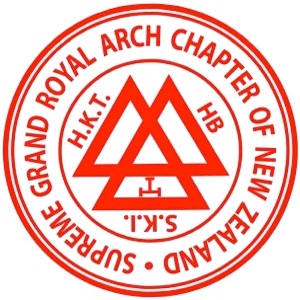Keynote Address to the Royal Arch Forum
SGRACNZ Grand Convocation Wellington 9 March 2012
RE Comp Alan Hart Grand Lecturer
Introduction
When I was asked to give a keynote talk today rather than what has been the recent custom at our Royal Arch Convocation, I must admit to feelings of trepidation.
My mind trawled over those various “key note” addresses that I have sat through in a variety of circumstances from school days with the assembly speeches by the principal.
Others were no doubt in their time memorable yet as with so many talks I have heard I couldn’t for the life of me remember any one specific one which I could model this one on!
So recourse to taxing the brain as to what I can recall from those and from asking others what they considered a “key note” address should be. Not surprisingly their response were as varied as I would no doubt receive from you here today.
Some professional ones related to what was a focus or specialist speech at such as a work conference. Others such as that I heard at a Charities Commission forum were designed to at least challenge the hearers’ preconception of the topic whilst raising some thoughts as to issues confronting organisations. Yet others such as Chancellor Ian MacKinnon at my daughter’s graduation last December spoke of what little he could recall from similar addresses given when he himself had graduated some 40 years before. The graduate responder spoke feelingly but also encapsulated the usual expectations with congratulations mixed with hope for the future.
The best ones referred to by others were those delivered by a speaker that were relevant to the topic and were short.
So with that in mind I recalled the story of one of Winston Churchill’s addresses to his old school prize giving when he is reported to have risen from his chair made his way to the centre of the stage, glowered at the audience and simply said “never, never, never give up” turned on his heels and returned to his seat.
The truth is far more prosaic but the force of his words still resonates. If you wish to read them all can I suggest that you ask Mr Google? The speech was made on 29 October 1941 to the boys at Harrow School and in part included “Never, never, in nothing great or small, large or petty, never give in except to convictions of honour and good sense. ‘’
So after going around the mind in so many ways my aim now is a simple one – to make your realise what you already know.
SWOT
Most of us are aware of the SWOT concept of looking at issues which may confront an organisation as opposed to the old school days meaning of “to study very hard and intensively, especially for an examination.”
Looking at the Strengths and Weaknesses of an organisation then seeing whether they are Opportunities or Threats seems easy enough but many fail to appreciate that all four aspects are intertwined. Threats can often be opportunities depending on your point of view as the Dali Lama so eloquently put it in a recent programme on a charity bike ride for child kidney awareness– recall that after the hurricane comes the rainbow.
R Matthews, in one work from 2005, showed it simply as a way of moving from the current situation to a desired future one i.e.
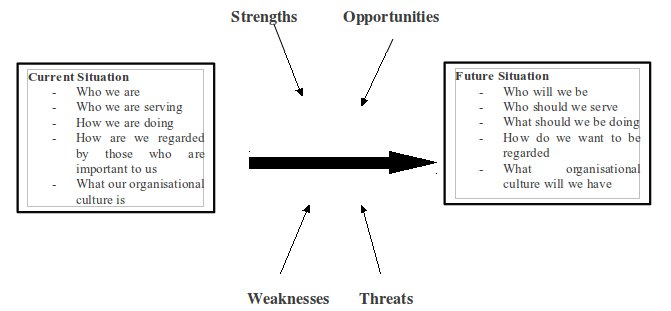 What is our problem – speaker after speaker and researcher after researcher both in New Zealand and elsewhere have laid out the facts of our declining membership for all to see for over 50 years now.
What is our problem – speaker after speaker and researcher after researcher both in New Zealand and elsewhere have laid out the facts of our declining membership for all to see for over 50 years now.
Firstly we should be aware that Nothing is new –
“The Freemasons are in so low repute now in England that one scarce heard the proceedings at Vienna against them mentioned. I believe that nothing but a persecution could bring them into vogue here again”. So said Horatio Walpole, 4th Earl of Orford (1717 – 1797) in 1743 – just before the publication of the Papal Ban) – an irrelevant connection but for those interested the Earl of Orford is a title that has been created three times and of its third creation the 5th & last Earl died in the Manawatu in 1931.
The earliest comment expressing concern on membership issues was in 1906 with reference to retention rates. In our own lifetime and for our own organisation at the Convocation in 1960 the then GZ raised the issue of declining admissions to the Order.
While M Ex Comp A B Christensen in his First Grand Principals address of 1954 referred to his concern at membership retention, as late as 1959 comments on Supreme Committees reports relating to the Condition of Capitular Masonry reflect a high degree of complacency grounded on a past history of opening new Chapters with artificially increasing membership.
Yet within a year the then outgoing First Grand Principal was concerned enough to raise this issue. In part he said “the numerical condition of our Order gives us cause for deep concern. Up to four years ago we were improving membership by approximately 200 per year. In 1957 our increase of membership dropped to 176. In 1958 the increase was 134. In 1959 it had declined to 91 and today you will be asked to consider a report for this year showing a net increase of only 25 members. If we do not act quickly to find and correct the cause of this decline then we may expect next year’s report to show a net loss in membership of some fifty members.. Our average intake of new and joining members for the past ten years prior to 1956 was 538 per year, which I consider to be ample supply for steady progress but during the last four years resignations have increased alarmingly and I therefore commend this report to your most serious consideration.”
Discussion on the actual clause in Supreme Committee’s report was limited to a single comment on the numbers of plural members.
In some ways 1961 was a watershed year for our Order. For the first time in its history Grand Chapter produced a real comment on the condition of the Order. The full report is at pages 21/22 of the proceedings of that year. In short it referred to M Ex Comp Boustridges comments of the previous year and a survey undertaken by Supreme Committee.
The findings were much as you would expect but concern was expressed at the hidden nature of membership attrition. A comment was made that “this position is more alarming when it is noted that for every four new members joining R A Chapters, three are lost by the resignation or strike off.
The report also covered some remedies covering 5 key aspects:
-
Within the Chapter – punctual opening, prompt dispatch of business, allocation of work etc.
-
In refectory – minimum of formality, few toasts, some entertainment or short feature, hour of relaxation etc.
-
General greater awareness of proposers & seconders of their responsibilities towards candidates, closer contact by Z with non-attenders, investigate number of meetings, and the real surprise “The possibility of opening in the degree which is to be the ceremonial work of the meetings. Minutes to be taken in the Mark & Excellent as well as R A degree”
-
Resigning members – attempt to obtain reasons; members transfer system
-
Intake of new members – closer liaison with Craft Lodges & Chapters, appointment of a companion in each Lodge who makes approaches to suitable prospective members, more reference to Chapters by Lodges preferably on their notices, greater mention by Grand Lecturers of the existence of Chapters.
The report concluded “the emphasis must be placed on endeavouring to retain the interest of existing members to guard against such occurrence” i.e. loss of membership each year.
Everything said at that time over the consideration of the report as printed also at pages 43 to 51 of the proceedings is still true and I can but suggest that you read the report and comments. But “plus ça change, plus c’est la même chose “Literally “The more it changes, the more it’s the same thing.” [An epigram by Jean-Baptiste Alphonse Karr in the January 1849 issue of his journal Les Guêpes (“The Wasps”)].
In my own membership from 1972 on I have seen a series of well-meant reviews of the Craft and our Order take place with little actual positive result, including that by the group of “young companions” of 1974. In 1994 when Grand Secretary I had the opportunity to meet with the Grand Secretary of Scotland who in part indicated that such rises and falls in membership had occurred many times in their Grand Lodges history and by implication that they had no intention of any knee jerk actions. I notice that their Lodges in New Zealand have not been immune from reductions in membership and wryly observe that were it not for members joining from the other constitutions many of their remaining Lodges would not be viable. Much the same is the case of the English and Irish Lodges operating in the sovereign country of New Zealand.
At the Craft Grand Installation in 1972 the then Grand Master asked in part “Can the present practises of the Craft stand up to the challenge of this age of rapid change? There is concern about a falling membership but the advent of all the modern mechanical aids to both amusement and education, modern affluence and a more materialistic outlook, a challenging and questioning younger generation, this seems inevitable until that same younger generation stabilises itself in the years ahead. They will be our successors and however it is done the message of Freemasonry must be passed on to them”
What has really changed in these past 60 years?
Secondly, do numbers actually matter?
As with many things it really depends on what is involved. But just to remind you:
Key membership data – 1892 – 2011
-
Royal Arch
Craft
Year
Members
Chapters
Members
Lodges
1892
279
12
2,897
81
1902
621
19
5,737
119
1912
1,504
30
12,197
183
1922
2,776
47
19,715
236
1932
3,886
70
26,618
300
1942
4,316
72
27,412
305
1952
6,759
86
39,790
363
1962
7,866
98
46,965
418
1972
7,028
100
42,812
430
1982
6,173
102
35,840
429
1992
4,262
97
23,551
350
2002
2,500
83
12,752
311
2011
1,482
61
8,700
260
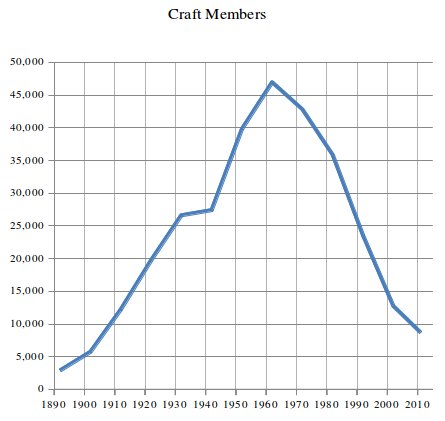
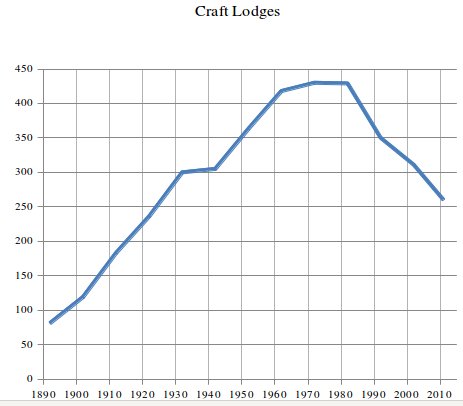

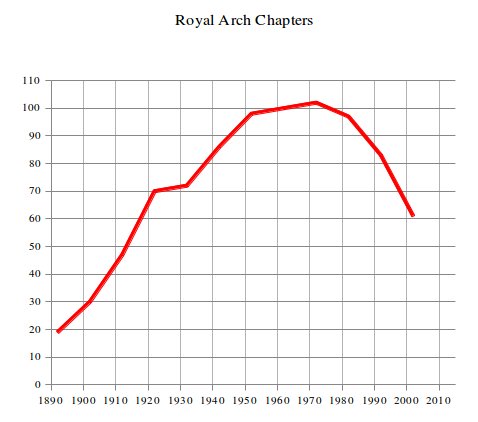
The last “true” new Chapter rather than a merged one was Jubilee No 108 in 1977. Our peak membership raw numbers were in 1960 with 7,910 members. Interestingly the Craft membership did not peak for another 2 years.
So my question to us all is:
“If not now, when” – which is a paraphrase of the words of Hillel, a Jewish religious leader from around 110 BC – 10 AD, who was associated with the development of the Mishnah and the Talmud. He is popularly attributed as the author of the saying: “If I am not for myself, who will be for me? And when I am for myself, what am ‘I’? And if not now, when?”
Many centuries later a sentiment much the same was popularised as to who the action desired must come from. If we acknowledge that the now is when the action must occur then the only issue is:
“If not us, who”
“First they came” is a famous statement attributed to Pastor Martin Niemöller about the inactivity of German intellectuals following the Nazi rise to power and the purging of their chosen targets, group after group. The text of the quotation is usually presented roughly as follows:
First they came for the communists, and I didn’t speak out because I wasn’t a communist.
Then they came for the trade unionists, and I didn’t speak out because I wasn’t a trade unionist.
Then they came for the Jews, and I didn’t speak out because I wasn’t a Jew.
Then they came for me and there was no one left to speak out for me.
And so to it may be for us if we don’t accept that the efforts to save our institution must come from ourselves.
Context and comparisons.
It seems to me that often the commenters on what ails the Craft and Masonry in general forget to have a look at what has been the context within which the country as a whole has been evolving over these past years. Yes our population has grown from about 1 million a century ago to its current 4.5 million and thus our membership in comparative terms is 20% of what it was then. Our male life expectancy in 1911 was about 60 years while it is now about 77 years which confirms what we know – we are living longer!
Again you all know this but just in case, were you aware of how few pleasure distractions were available for our forebears of the late 19th Century when the expansion of Masonry was underway? Apart from Church, one or 2 Benevolent Societies, Military groups, musical groups and sporting ones there was no real competition for a man’s time or at least his leisure hours.
Jock Phillips in his excellent “Men’s Clubs” in the online article for “Te Ara, the Encyclopaedia of New Zealand” outlines these and gives details of their history, growth, maturity and current state which is far more expansive than I wish to go to here. Suffice it to observe that the causes for decline in membership of each of them reflected societal changes which many of you here today have grown up with and probably taken for granted. He comments in relation to Men’s Clubs themselves that their decline late in the 20th Century was primarily due to the following causes:
-
The increasing number of working couples, with men taking a greater part in household duties
-
Feminist criticism of exclusively male organisations, and a move away from single sex socialising
-
Alternative forms of leisure entertainment and
-
More paid work over the weekend.
I don’t fully agree with him in that while some males are more involved at home often this is not truly at the expense of their leisure opportunities. Our target market is also now more with those males in say their 30’s to 50’s than in the past and while child rearing days have changed with more couples (married or not) having their first child at a later stage than some previous generations it seems from my observations to be rather simplistic to suggest that men don’t join the Craft due to these roles.
Have you ever stopped to think about the sheer growth and diversity of competition for a man’s time?
Just for ease of reference I will list those I know from Phillips article and other sources as existing in say 1912 and those existing now but I warn that the latter group is too extensive to list in full.
-
Work
-
Family including house building & maintenance
-
Church
-
recreation in the sense of gardening or hunting/fishing for own food
-
Freemasonry
-
Loyal Orange Order (from 1842)
-
Savage club (from 1885)
-
Knights of the Southern Cross from Catholics
To these must be added those groups which while exhibiting some aspects inimical of Freemasonry were established or mutual self-help such as:
-
Royal Antediluvian Order of Buffaloes (since 1920)
-
Manchester Unity Order of Odd Fellows (from 1861)
-
Ancient Order of Foresters (from 1872)
-
The Independent Order of Odd Fellows (from 1862)
-
The Temperance Societies – 3 with the Rachabites (from 1863); the Independent Order of Good Templars (from 1872); and the Sons & Daughters of Temperance (from 1871)
-
The Hibernian Society – for Catholics similar to the Odd Fellows.
To these could be added the political parties of the day and local authority service including such as on pest and roads boards just to name 2.
What have we got now in 2012?
Some of the above have faded or are in a worse situation as regards their membership than Freemasonry is. But just in one area if I could mention that after the introduction of the new Charities Act in 2005 there are now in excess of 25,000 organisations or units registered under its provisions! There are also about 97,000 Not-for-Profit organisation operating with a combined income of about $9.5 billion with an associated expenditure of about 4.9% of total GDP.
There is a rainbow group of societal bodies now existing which a Century or even 50 years ago simply didn’t – these cover small groups often with a very tight focus including areas of spirituality, sexuality, educational or sporting interest.
Have we lost our relevance?
As anyone involved with strategic planning will tell you one of the first things you need to do is be sure of what your purpose is or what it is that makes us different from a myriad of other not for profit organisations vying for peoples time.
Have we become confused? Charity seems often to be the main reason for many members as to why we exist yet while we take great pride in our benevolent work whether it is in the Craft or our Royal Arch Jubilees and Centennial Scholarships our numbers continue to diminish.
An article late last year about the Royal Antediluvian Order of Buffaloes indicated that their Wellington Lodge had recently sold and purchased new buildings to meet in. Part of the article indicated that the old building was “a lovely place but it was decided to sell as members were finding it too tough to get up the stairs.” Their President said “we have only got 8 members at the moment but with the new premises we hope to get back up to 10 or 12. They meet every fortnight to socialise – singing along to the piano or guitar and telling stories. The Real Estate agent involved in the sale and purchase of the 2 building involved (both at around a $1 million) recalled that when he had assisted the Lodge to buy its previous building in 1976 it had something like 130 members.
Are we much like them with our attitudes to buildings where we haven’t seemed to be owners with any degree of skill notwithstanding those some of our members have professionally? We definitely have many millions of dollars involved in buildings which seem to take an inordinate amount of energy to mismanage. Equally some buildings seem to be the personal fiefdom of one or two members for whatever reason.
Are we a motivational agency or perhaps a philosophical one? Or are we a social membership group safer to go and have a drink with than down at the pub?
Some comments as to what we may have been doing wrong
We have known that there is a problem with the issue of membership since at least the 1960’s as I mentioned before.
As some of you here will attest I have tested the waters to a limited extent to gain some observations as to why some of what we have done over the past 50 years seems to have been in vain. Without any particular ranking these observations included:
-
Competition for time and financial issues have meant we have compromised our principles to try and get numbers of new members while at the same time we have been losing them often in their first year or two of membership.
-
Poor leadership – many top level Grand officers have seemed more concerned with their own perceived status and self-image than giving true leadership.
-
Antipathy of some Craft masons to the Royal Arch and other Orders in general.
-
Reduction in Craft membership has lead us to believe our own reductions are inevitable.
-
We seem to be afraid of people of differing abilities to ourselves.
-
There are still some at all levels with an attitude of “I had to wait for promotion to Grand Rank and serve in all the respective offices so why shouldn’t he” – the “tall poppy” syndrome.
-
Our focus has been wrong – if we have had one at all – reflects the relevance issue and whether we are a philosophical organisation or “Rotary with ritual”.
-
The wrong men are joining the craft and thence the other Orders.
-
Members are seeking self-aggrandisement – bring on the bling!
-
Patronising attitude by some of the elders and betters to newer members whatever their age may be.
-
We seem doomed to reinvent the wheel and often pay lip service to previous efforts and initiatives – if we don’t learn from the past we seem doomed to repeat its mistakes.
-
We suffer from paralysis by analysis.
To which I would add but one observation from reading almost all the proceedings of Grand Chapter from 1892 on. From these it appears that we have spent more time and effort discussing the allocation of Grand Chapter Officers than membership issues.
Some deeply philosophical thoughts!
As we grow older we grow wiser and more foolish at the same time. Over the past few years I have often been reminded that there are in essence only two real truths.
-
There is no magic bullet
-
If it is to be, it is up to me
Both are true whether it be for personal health or for that of an organisation. The first reminds us that there is no single right answer or course of action which if we only followed it would cure all our membership ills. Even God needs a little help from time to time. The second reminds us that there is no real “nanny state” someone somewhere has to do it whatever it is.
To these 2 thoughts I might also add another – we tend to make generalisations.
Equally my work and the environment within which I work has pointed out to me on many occasions that there are no truths as such but rather our perceptions of an issue and even these may change over time or location.
Yet how often have we all heard sotto voce comments at meetings from members as to words or actions by one of the players in our ceremonies not being strictly according to the ritual as though the speaker was correct and the other Companion/Brother in error. We have all heard countless prompts which are incorrect.
Occasionally we also hear what could at best and with a charitable view be considered to be double headed comments meant to be open but which in reality can hurt the recipient. A kindly word well intended will help keep members while sycophantic ones may well be seen by others for what they are. Equally our actions must match our words. No doubt you have all sat in refectories where members do not even pass plates to the end of the table let alone help newer members who are often our stewards by taking them to the kitchen. Do they really expect to be waited on hand and foot simply because in the good old days that’s what the younger ones did and it’s now their turn?
We have also heard members deliver parts of our ceremonies in what could be thought word perfect manner. Yet while the words have been according to the printed ritual, we have all heard them delivered in a manner which suggests that the deliverer doesn’t actually understand what they mean.
Goding and some others have called this the “cringe factor” but perhaps they are being too kind and it is really just bad manners. We learn from what we observe. As Lance Armstrong said “It’s not about the bike.”
Personally, I prefer the attitude expressed by R W Bro Ted Simmons, OAM in the June 2010 issue of the NSW Freemason where under the editorial heading of “Just shut up and do it!” the sub heading said it all “Actions speak louder than words.” To which I would simply repeat a sentiment from Robert Heinlein’s character Juan Rico in Starship Troopers “Don’t just stand there, do something.”
So what’s the answer?
As I indicated earlier I personally do not believe that there is any one single answer to the issue of declining membership. Gen Y sees the world differently from many of its predecessors. That doesn’t mean that individually they don’t want to be involved with groups such as us simply that their approach to membership is different to those who gained long service awards of the past. Men such as Sam Johnson of the Student Army in Christchurch are unlikely to join a more formal group but they have demonstrated their commitment to society as a whole. As Dick Hubbard observed in Clipboard 118 “The Christchurch Student army reaffirms one’s faith in youth. For every identified individual hero, there have been thousands of unsung ones. I have never felt so proud to be a New Zealander.”
M Ex Comp Christensen back in 1954 amongst other observations on members understanding of the Royal Arch noted “far too many Chapters still fail to deliver the RA Lectures which contain the whole story and too little attention is paid to the scriptural references embraced in the degree.” Nothing has changed over the succeeding 58 years and this is one particular recommendation I personally would urge members to consider.
The remedies suggested in the 1961 Report and those which followed remain valid and with some revision will help those Chapters which truly embrace the need for action. Some answers will be simple but need real commitment to change which is not easy for any of us.
V Ex Comp Bernie Harris several years ago wrote that “Working co-operatively with other Chapters is the guarantee that caring and sharing must inevitably demonstrate the importance that strong craft lodges will have on the future of the Royal Arch. Planning, teamwork and positive co-operation has always been preferable to its alternative – complacency, resistance to change, and negativity. History has the records of all the failures that we won’t repeat, so let’s learn from them and then look forward. Losers look backwards,”
Bernie and other members such as him are those who see that the bottom half of a glass of water must mean that a positive future for Freemasonry and the Royal Arch will flow from a determination to act deliberately whenever that is necessary. He and they havea positive personal attitude based on a personal conviction that “persistence and determination are omnipotent” andthat “A conviction that enthusiasm, enjoyment and education are automatic when positive planning is followed by confident implementation of those plans”
Conclusion
We are not alone or unique.
Last year the Minister of our local church returned from the Uniting Congregations Biennial Forum and reported back to our parish. In part he mentioned the learning and challenges involved referring to Winston Churchill words that “Failure is not in falling down but in not getting up.” He also pointed out that many churches are becoming focused on maintenance whether that be buildings, traditions or the present congregation all of which can be a barrier to the future. From the disaster of Christchurch came the observation that the work continues in spite of the loss of physical buildings. When a church building or hall is gone the Church is not gone as the people are still there and the message remains but we may have to do things differently.
So too is it with us. Let us hold fast to the principles we espouse and stay true to the philosophy of the Order.
The piece of cut line you all have is symbolic of such an approach – individually the small pieces are virtually useless but it is what we do with them which matters. Put together they make a mighty rope (thanks to Scouts)
You may recall that earlier I said that my aim today was simply to make you realise what you already know.
I trust that I don’t need to spell it out but the phrase “If it is to be it is up to me” may help.
Copyright © Alan L Hart, SGRACNZ, 2012
SGRACNZ
royalarch.org.nz
